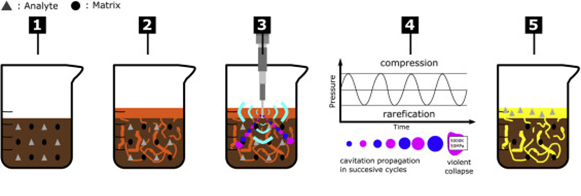Nowadays, consumers are more inclined to choose the foods which not only possess the necessary biomolecules for various metabolic activities, but also have long-term positive effects. Majority of the active ingredients in cash crops are present in the cells and need be released into extraction solvents during the extraction process. Conventional extraction methods include decoction extraction, soxhlet extraction, solvent extraction, steam distillation extraction,high hydrostatic pressure extraction, pulse electric field process, and high pressure process, among others. However, traditional methods have the disadvantages of low extraction rate, large solvent consumption, high energy consumption and long time consuming.
Green extraction is an inevitable trend in natural products research, the concept of green extraction has been proposed by many researchers. Green extraction means reducing solvent, energy, wastes and environmental pollution while obtains the addition of yields. The green extraction technology should be the result of industrial competition more ecologic, economic, and innovative. Therefore, in-depth exploration of safe, green and cost-effective extraction methods, particularly in developing novel technology to meet the requirement of energy costs and greenhouse gas emissions reduction, is paramount. Driven by the green extraction goals, some new extraction technologies have been developed, such as microwave extraction (ME), supercritical fluid extraction (SFE) and ultrasonic-assisted extraction (UAE), among others.
Interestingly, the special interest in ultrasound is due to its green impacts on bioactive compounds extraction process, such as higher product yields, shorter processing time and maintenance costs. Ultrasound-assisted extraction (UAE) uses ultrasound energy and solvents to extract target compounds from various plant matrices. Ultrasound are the mechanical waves having frequency (> 20 kHz) higher than audible frequency range of human hearing (20 Hz to 20 kHz). These waves consist of a series of compression and rarefaction cycles that can be propagated through solid, liquid or gas medium inducing displacement and dislodgement of the molecules from their original positions. At high intensity sound wave, the negative pressure during rarefaction exceeds the attractive force joining the molecules together pulling them apart and creating cavitation bubbles. These bubbles grow through coalescence and later collapse during compression phase creating hot spot and extreme local condition.
    |
 |
| Figure 1. Principle of UAE. 1) Sample is placed in vessel. 2) Extraction solvent is added. 3) Sonotrode is placed in contact with sample. Sonication of sample. 4) Ultrasound cavities propagation and implosion leads to localized high temperatures and pressures resulting in enhanced extraction. 5) Sample ready for clean-up process. |
Acoustic cavitation is the main mechanism involved in the ultrasound assisted extraction. The collapsing cavitation bubbles and the sound waves may induce either one or combination of the phenomena such as fragmentation, localised erosion, pore formation, shear force, increased absorption and swelling index in the cellular matrix of the plant. The collapsing cavitations bubbles generate shockwaves and accelerated inter-particle collision causes the fragmentation in cellular structure. The rapid fragmentation leads to solubilisation of the bioactive component in the solvent due to decrease in particle size, increased surface area and high mass transfer rates in the boundary layer of solid matrix. Ultrasound leads to the localized damage to the plant tissues termed as erosion. This erosion may also be attributed to the implosion of the cavitation bubbles on the surface of plant tissues. The eroded part facilitates the contact of solvent, increasing the yield of extraction. The formation of pores duringcavitation, a phenomena knows as “sonoporation”, in the cell membranes results in the release of the bioactive compounds present in cell. In addition to that, the generation and collapse of cavitation bubbles induces shear force and turbulence within the fluid which results in breakdown the cell walls contributing to releasing the bioactive compound. Ultrasound increases the water absorption of the pomace thereby enhancing the accessibility of the water as solvent to the bioactive compounds to be extracted along with increased diffusivity of the bioactive compounds itself. Ultrasound also increases the swelling index of plant tissue matrix which helps in both desorption and diffusion of solutes resulting in increased extraction.
References
1. Kumar, K., Srivastav, S. and Sharanagat, V.S., 2021. Ultrasound assisted extraction (UAE) of bioactive compounds from fruit and vegetable processing by-products: A review. Ultrasonics Sonochemistry, 70, p.105325.
2. Wen, C., Zhang, J., Zhang, H., Dzah, C.S., Zandile, M., Duan, Y., Ma, H. and Luo, X., 2018. Advances in ultrasound assisted extraction of bioactive compounds from cash crops–A review. Ultrasonics sonochemistry, 48, pp.538-549.
3. Snow, N.H., 2020. Basic Multidimensional Gas Chromatography. Academic Press.
ThS. Le My Hanh. Department of Food Nutrient and Science